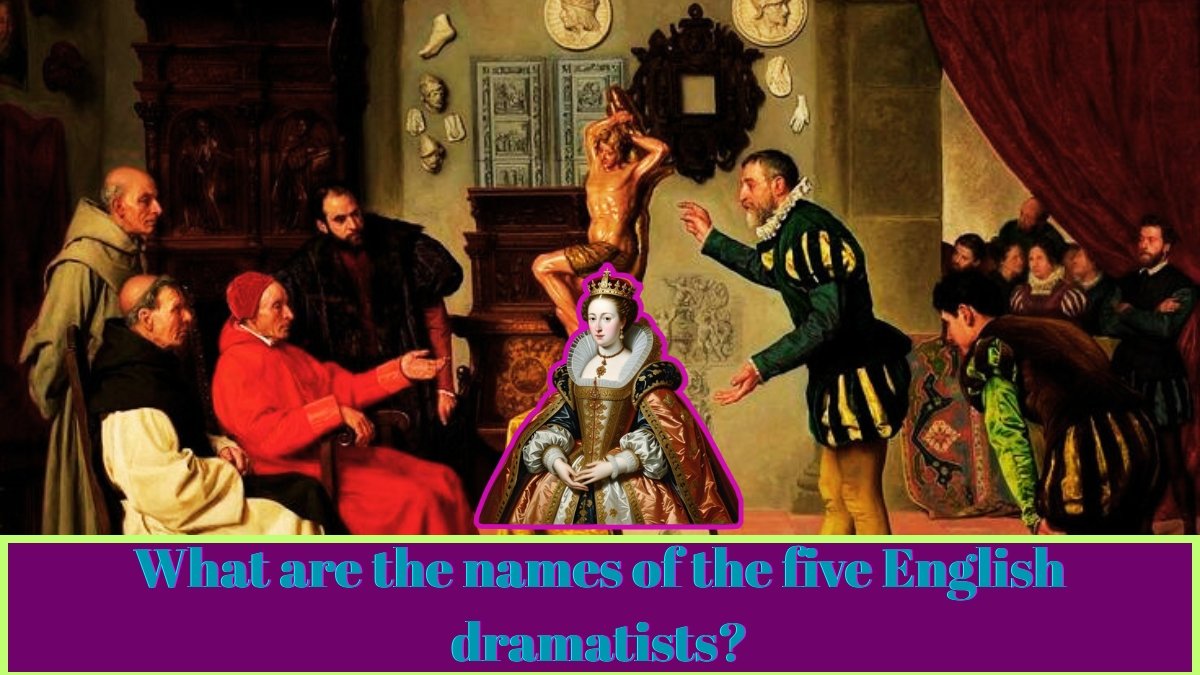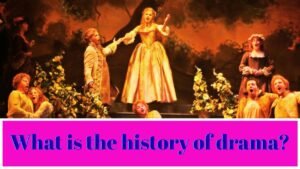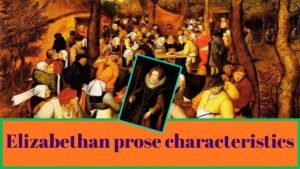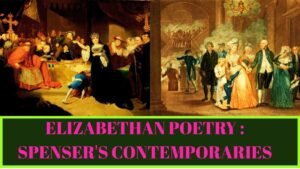What are the names of the five English dramatists?
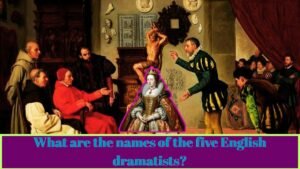
The term Elizabethan stretched to include Jacobean and Caroline dramatists-Ben Jonson and the ‘humour’ comedy-Estimate of Ben Jonson: his failure in tragedy, his success in comedy-Decline of the drama after Shakespeare-Chapman-Dekker’s Shoemaker’s Holiday-Middleton–Heywood’s realistic tragedy–A Woman Killed with Kindness–Tourneur-Webster’s White Devil and the Duchess of Malfi-Beaumont and Fletcher: The Knight of the Burning Pestle and Phllaster–Massinger’s A New Way to Pay old Debts-Ford and Shirley.
Shakespeare’s greatness has so eclipsed his contemporaries and successors in drama that it is only by an effort that we remember them and their plays. Shakespeare is, as it were, the central sun round whom are grouped the others like so many stars hardly visible in his daylight. But some of these stars are brilliant enough and shine in their own light, if we forget the sun for a moment. As such they deserve a place in any literary history.
The literary historian is, however, faced with the problem of chronology. For, some of these dramatists who were Shakespeare’s contemporaries lived and continued to work long after he was dead, while others who were his successors worked in the reign of Charles I. They should, therefore, be properly called Jacobean or Caroline dramatists, but as the spirit that animates their plays is still, in the main, Elizabethan, it would be better to group them together and call them all Elizabethan. This would not only facilitate an un-interrupted study of the drama which is the most glorious achieve-ment of the Elizabethan age, but would also enable the student to see this achievement in its right perspective. The term Elizabethan in this chapter is, therefore, stretched to include the Jacobean and Caroline period down to the closing of the theatres in 1642.
Though the total output of plays by Shakespeare’s contempo-raries and successors is very large and the quality of the best ou them very high, only the briefest notice of them and their au: 10.8 is possible here.
Ben Jonson (1573-1637). The greatest of the group of writers for the public theatre outside Shakespeare was Ben Jonson. As Marlowe had been Shakespeare’s greatest rival in his earlier career, so was Ben Jonson in his later. He had a varied and adventurous career. He was educated at the famous Westminster School and though he did not go up to the University, he was honoured by both the universities. Starting as a bricklayer he passed to soldier-ing, then to acting on the stage and finally to play-writing. He killed a fellow actor and was branded for life on his left thumb. He was involved in bitter quarrels with other dramatists, notably Dekker and Marston, the latter being thrashed by him. For his share in the comedy Eastward Ho! which offended King James by its satire on the Scots, he suffered imprisonment along with his collaborators, Chapman and Marston, and came very near to hav-ing his ears and nose chopped off. He travelled on foot to Scotland where he visited the Scottish poet William Drummond of Haw-thornden (near Edinburgh). Drummond’s notes of this visit are the source of many details of his life and character that have come down to us. He wrote masques for the court and enjoyed the patronage of James who made him court-poet or poet laureate. (A masque is a short dramatic piece or interlude with elaborate scenery, music, dance, gods and goddesses. It developed into the later opera.) In his later life he was a sort of literary dictator like his more famous namesake of the 18th century He died in poverty and was buried in Westminster Abbey. The short and simple epitaph on his tomb reads: O Rare BEN JONSON!
The character Drummond gives to Ben Jonson is not flattering and this is confirmed by his tempestuous life as well as by his plays. He was undoubtedly a great classical scholar, but was proud of his learning and contemptuous of those less lear learned. He was self-complacent, aggressive and arrogant. Despite all this he was capable of warm friendship. He gathered red round him a crowd of admiring disciples known as the “sons” or “tribe of Ben”, and his wit-combats with Shakespeare at the Mermaid Tavern have left a pleasing picture of his rough good nature.
Ben Jonson struck out a new line in drama. He had critical theories of his own to which he adhered strictly in practice. These theories led him to model his plays after classical patterns. He set himself as a reformer of the Elizabethan stage with whose romantic tradition he was wholly out of sympathy. Though he was friendly to Shakespeare and worshipped him ‘this side idolatory’ he cannot be said to have been his enthusiastic admirer. In fact, he was in many ways a complete antithesis of Shakespeare. Shakespeare did not theorise about his art and accepted the conditions of the stage as he found them. In writing he was a law unto himself and wrote as he pleased without caring for rule or authority. Ben Jonson conformed strictly to the rules of classical drama. He observed the ‘unities’ while Shakespeare flouted them. He kept tragedy and comedy rigidly apart instead of mixing them as Shakespeare did. He was scrupulously accurate in his historical facts and is never guilty as Shakespeare is, of anachronisms. His two tragedies Sejanus and Catiline were the result of elaborate reading and research and are heavily documented, but have nothing to recom-mend themselves except their documentation. They are pedantic and dull.
In comedy he was more successful. In the prologue to Every-man in his Humour he attacked the romantic conventions of contem-porary theatre and expounded his own theory of drama. Speaking of comedy he observes:
But deeds and language such as men do use, And persons such as comedy would choose When she would show an image of the times And sport with human follies, not with crimes.
His comedies are accordingly realistic and with one exception ridi-cule the fads and follies of contemporary London. The exception is Volpone which whi deals not with fools but criminals. Volpone, his arasite Mosca and Voltare, the lawyer, are unmitigated rascals and hardly the stuff of comedy.
The best known comedies of Ben Jonson are Everyman in his Humour, Epicoene or The Silent Woman, The Alchemist and Bartho-lomew Fair.
The comedy which Ben Jonson created is known as the comedy of humour-humour not in its modern but medieval sense. It was supposed that everyman had four ‘humours’ or fluids in his body-choler, bile, phlegm, and blood. The preponderance of one of these gave a distinct twist or bias to a man’s disposition. Choler made him choleric or irritable, bile melancholy or pessimistic, phlegm phlegmatic or slow and sluggish, and blood sanguine or lively and optimistic. Humour thus came to mean an idiosyncrasy, eccentri-city or oddity of character. Ben Jonson seizes upon the characteris-tic ‘humour’ or eccentricity of a character and exaggerates it to the point of absurdity. This conception of character is illustrated in Ben Jonson’s first comedy Everyman in his Humour which is the key to all his comic plays. We have here old Knowell whose humour is his excessive anxiety about his son’s morals; Brainworm, the clever servant; Kitely, the jealous husband; the town gull Matthew, a pretender to poetry; the country gull Stephen who affects the fashionable humour of melancholy and wants a stool to be melan-choly upon; Downright whose humour is irrascible bluntness; Boba-dill the cowardly braggart; and Justice Clement, the merry magis-trate. It will be seen that Ben Jonson gives to his characters signifi-cant or tell-tale names. This method of characterization makes the play resemble a morality with its personifications of virtues and vices. Each character becomes the embodiment of one quality to the exclusion of all others. This is the method of caricature and makes Jonson’s characters lop-sided. Bobadill, the most entertain-ing of all, is the only character of Ben Jonson’s that li memory. Dickens used the same method, but work: larger canvas of the novel and having broader hur was able to create well rounded characters that are as classic as Shakespeare’s.
The most delightful of Ben Jonson’s comedies is Epicoene or The Silent Woman. Morose is a rich old bachelor whose humour is his hatred of noise. He lives in a narrow street which cannot admit vehicular traffic. The floors are heavily carpeted to muffle the tread of the servants’ feet draped in thick socks. The lock in the door and the hinges are oiled every day. The servants speak to the master by signs such as raising a leg or holding up a hand or finger. He dismisses a servant because of his noisy boots. He does not approve of his nephew Eugenie and to cut him off from inheritance decides to marry, if he can get a perfectly silent woman. Cutbeard, his barber, in league with Eugenie, finds such a woman in Epicoene. The marriage ceremony is performed by a parson who can hardly speak because of a bad cold. When the parson coughs after the ceremony, he is asked to give back five shillings of the fee paid to him. He saves it only by coughing more on Cutbeard’s instructions and is thrust out of the house.
Immediately after the marriage the wife finds her tongue which she begins to use vigorously by scolding the husband and counter-manding his orders. A party led by Eugeine and his friends complete with a band now enters to celebrate the wedding. Horrified by the noise Morose escapes out of doors in his night caps to see if he can get a divorce in the law-courts. He is so frightened by the noise of wrangling lawyers there that he hastens back home. A friend undortakes to get the case decided in the house by calling a lawyer and a parson who are no other than Cutbeard and Otter, a sea captain, both, disguised. After lengthy and noisy argument with a lot of Latin thrown in, it is concluded there is no valid ground for divorce. In this predicament Eugenie offers to get his uncle rid of the woman if he allows him five hundred pounds a year during life and names him his heir after death. On Morose’s agreeing to the terms Eugenie pulls off Epicoene’s wig and other disguises to discover her a boy!
Of the other comedies of Jonson, three-Everyman out of his Humour, Cynthia’s Revels and The Poetaster -are tedious, being dominated by satire and self-praise. Cynthia’s Revels is redeemed by the song: ‘Queen and huntress, Chaste and fair’, one of Jonson’s most beautiful lyrics. The Poetuster dealing with the literary quarrels and rivalries of the day is a scathing satire on Marston and Dekker.
In pleasing contrast to these are Eastward Ho! and Bartholomew Fair. They are intensely realistic pictures of London life rendered in a vein of genial humour not typical of Jonson.
Though realism was the strong point of Ben Jonson, he was not without a delicate poetic vein as is evidenced by his unfinished pastoral drama, The Sad Sheperd or A Tale of Robinhood. Besides, the large number of masques he wrote contain delightful poetry. His song ‘Drink to me only with thine eyes’ is one of the most famous lyrics in the language.
Estimate of Ben Jonson. Though Ben Jonson failed in his attempt to turn tragedy into classical channels, he did succeed in infusing classical spirit of realism in comedy. His contemporaries and successors continued to produce romantic tragedies but they were markedly influenced by Ben Jonson in their comedies, which are realistic portrayals of contemporary London. The one great value of his own comedies is the light they throw on the fashions, fads, and follies of Elizabethan England. Taken together they constitute a solid social history of the times. A play like Everyman in his Humour tells us more of how the Londoners of his day lived and talked than all the plays of Shakespeare. Shakespeare transcended local limits and in Ben Jonson’s words ‘was for all time’; he himself, however, was ‘for an age’-his own.
As a dramatist he had great originality or inventive power, technical skill, learning, wit, vigour of language. If he failed to produce memorable characters it was because his temper was essentially satirical. Satire implies exaggeration and what is easier to exaggerate than an oddity or ‘humour’? Satire is not barred from comedy, but Jonson is uniformly satirical. His excessive pre-occupation with censure led him to load his characters with ‘humours’ which make them ‘types’ rather than individuals. In this sense he is less realistic or classical than Shakespeare. He lacked the universal charity of Shakespeare who could sympathise even with his bad characters without in any way upsetting the moral norm. Besides, Jonson’s plays are marred by egotism, pedantry and coarseness. He could not help an allusion to himself as a famous writer even in such a delightful play as The Silent Woman.
He was a brilliant writer, and his plays are clever but not charming. Dryden summed up this general feeling about Ben Jonson when he said:
I admire him but I love Shakespeare.
Ben Jonson by his importance d manded and has received more space than can be given to the others. Though all of them cannot be called decadent, there is no doubt that the drama declined after Shakespeare. Lacking his genius. his charity and his essential morality, the dramatists catered to the low tastes of a frivolous audience by writing plays which are coarse, artificial and sensational. We have noted the coarseness of Ben Jonson; in his contemporaries and successors it becomes more pervasive. Some of them revelled in licentiousness and sensationalism for their own sake The stage which the Puritans had always hated as immoral became in course of time definitely so, until the Puritan Parliament coming into power closed the theatres in 1642.
Chapman, made famous by Keats’s sonnet as the translator of Homer, was rather a reflective and didactic poet than a dramatist. He completed Marlowe’s Hero and Leander and collaborated with Heywood, the most prolific playwright of the age, is said to have had a hand or at least ‘a finger’ in more than two hundred plays of which about forty are still extant. Only one of these. however, is famous. This, A Woman killed with Kindness (1603), is a realistic stic tragedy of domestic life, a type which has only two others (Arden of Feversham and the Yorkshire Tragedy) in the entire field of Elizabethan drama. This is the pathetic story of a good wife who succumbs to temptation in a moment of weakness. The outraged husband punishes her with complete isolation but provides her with money, servants and all comforts. The repentant woman starves herself and is forgiven just before her death. Heywood’s kindliness and simple humanity shines through this play. Lamb described him as ‘a sort of prose Shakespeare’.
Tourneurand Webster, generally mentioned together, wrote highly sensational tragedies dealing with the life of Ranaissance Italy, notorious for voluptuous pleasure, vice and violence. Tourneur’s two plays The Revenger’s Tragedy and The Atheist’s Tragedy are gloomy melodramas little read today. Webster’s plays, however, are much superior. His White Devil and The Duchess of Malfi for all their sensationalism display tragic power which is second only to Shakespeare’s.
The White Devil (1608). The play is founded on Italian history and dramatises events that took place in the 1580s. The white devil is Vittoria Corombona, a famous courtesan of Rome. She is the wife of a poor gentleman, Camillo. Of her two brothers, Flaminco is the secretary of Brachiano, duke of Padua, and Marcello an attendent on Fransisco, duke of Florence. Flaminco acts as a pander and helps Brachiano to seduce his sister. They contrive the death of Camillo and Isabella, wife of Brachiano and sister of Fransisco. Vittoria is tried for murder and adultery. As there is no direct proof of murder, she is found guilty of adultery and confined in a house of convertites or a penitentiary for prostitutes. She is carried off from there and married to Brachiano. Flaminco quarrels with his innocent brother Marcello and kills him. Fransico avenges avenges Isabella by poisoning Brachiano, and his accomplices kill Vittoria and Flaminco.
The play has some beautiful passages which recall Shakespeare. Cornelia’s grief over the dead body of her son Marcello recalls Ophelia’s distracted speeches, while her dirge ‘Call for the robin-red-breast and the Wren’ is one of the most beautiful things outside Shakespeare. Flaminco, the blackest scoundrel in the play, gives vent to some sentiments almost Baconian in their shrewdness. It is better to be fortunate than wise’. ‘There’s nothing of so infinite vexation/As man’s own though’s’. But the palm for tragic dignity is carried off by Vittoria. In the trial scene she recalls Portia with her daring wit and noble bearing. At the end when the murderers pro-pose to kill her waiting woman first, she rises to the heights of Cleo-patra and says: ‘You shall not kill her first; behold my breast ‘I will be waited on in death my servant/shall never go before me’.
The Duchess af Malfi (1614). This play is based upon a story of Bandello’s. The duchess a young, beautiful and high-minded widow secretly marries Antonio, her steward, inspite of the warning of her brotliers, the Cardinal and Ferdinand, duke of Calabria, not to remarry. The ostensible reason for opposition to remarriage is the consideration for their royai Spanish blood, but the real motive is their desire to inherit her wealth. They plant Bosola, a former galley-slave, in her employment to spy upon her. The duchess becomes the mother of three children by Antonio. Bosola ferrets out the secret and reports to the brothers. The Duchess and Antonio decide to separate and flee. Antonio escapes with the eldest child but the Duchess is captured with her two children. She is confined in her palace and is subjected to prolonged mental tortures Ferdinand visits her in the dark and under the pretext of shaking hands gives her the severed hand of a dead man Then she is shown the artificial figures of Antonio and her children as dead. As a climax to these tortures madmen from a mental hospital are let loose upon her to drive her to despair. At last she is delivered from her misery when her tormentors strangle her and her two children. Ferdinand seeing her dead body is touched with remorse and utters the oft quoted line: ‘Cover her face; mine eyes dazzle: She died young’.
Nemesis soon overtakes the culprits. Ferdinand becomes mad. Bosola frustrated in hopes of reward kills poor. Antonio mistaking him for the cardinal. But the cardinal does not escape; Bosola kills him and is himself killed by the mad Ferdinand.
Beaumont and Fletcher. This famous pair whose joint work
is the most voluminous of any of the major dramatists enjoyed great popularity in their own day and were still popular in the 19th century. They carried on, in the main, the romantic tradition of Shakespeare.
Their plays are distinguished for their exuberance, variety, poetic fancy, graceful language, smooth versification and high technical skill. These merits are, however, counter-balanced by their low ethical standards, artificial and unnatural sentiments and, above all, by their poor grasp of character. Not a single character of theirs is remembered. Though it is impossible to identify the separate contribution of the two, Fletcher is believed to have been the greater poet and Beaumont the greater technician. Fietcher’s collaboration with Shakespeare in Henry VIII and The Two Noble Kinsmen has aiready been noticed. Of the plays he wrote singly the most gopular is The Faithful Shepherdess, a pastoral drama of great poetic beauty. The joint work of Beaumont and Fletcher consists of fifty-two plays of which the most important are The Knight of the Burning Pestle, Philaster, The Maid’s Tragedy, A King and No King.
The Maid’s Tragedy is striking but unconvincing as the writers have not been able to harmonize character, motive, and action. A King and No King brings in incestuous love between brother and sister which, even after the later revelation that they are not brother and sister, leaves a bad taste in the mouth. The other two are more successful and may be read in any anthology of Elizabethan plays.
The Knight of the Burning Pestle (1609). This is a capital farce. It differs from the usual run-of-the mill comedy in that two members of the audience assume the role of stage managers and interfere in the action. A Citizen (a grocer) and his wife leap on to the stage and insist that their apprentice Ralph be given a part to honour the grocers’ trade. Ralph accordingly appears as the Knight of the Burning Pestle and performs various absurd adventures like those of Don Quixote. The main action which concerns the love of Jasper, a merchant’s apprentice, for his master’s daughter Luce, becomes a secondary affair and is halted at will to suit the whirms of the two stage dictators. They make ridiculous comments on the action and order everybody about, even giving sweets to Ralph and the stage boy by way of appreciation and encouragement. They confuse the stage action with reality and help out Ralph from tight corners. When the Knight is threatened with arrest for failure to pay 12 shillings at the Bell Inn, they pay from their own pocket. When the Knight is departing from the court of Moldavia where he has been lavishly entertained, they give him a few shillings to enable him to tip the King’s house-hold including the Princess, who gets three pence to buy pins at Bumbo fair! The disarming simplicity of the Citizen and his wife and their mutual affection make a delightful picture of domestic felicity.
Philaster (1611). This is a tragi-comedy of the kind we find in Cymbeline. The King of Calabria (southern Italy) has usurped the kingdom of Sicily. Philaster, the rightful heir is loved by Arethusa, the usurper’s daughter, who loathes Pharamond, the prince of Spain whom her father wants her to marry. For commu-nication between them Philaster gives his handsome page Bellario to Arethusa. Bellario is no other than Euphrasias, the daughter of Dion, a Sicilian lord. Under the pretext of going on a pilgrimage she has assumed male disguise in order to serve Philaster whom she loves but cannot marry because the prince is above her class. Arethusa declining Pharamond’s proposal to anticipate marriage rights, he finds solace in the arms of Megra, a court lady of easy virtue. They are caught in Pharamond’s bed-room. Megra becomes furious and retaliates by accusing Arethusa of misconduct with Bellario. Dion who from patriotic motives does not want Philaster to marry the usurper’s daughter, gives credence to the accusation and perjures himself by confirming it as an eye witness. Philaster mad with jealousy wounds the princess and Bellario and is taken prisoner. The city rebels in favour of Philaster and captures Pharamond. The rebellion forces the king to release Philaster who rescues Pharamond and restores peace. Bellario’s identity being disclosed, Arethusa is cleared of the charge against her. She is united to Philaster whose kingdom is restored to him. Everybody is forgiven at the end, even Dion who had deliberately libelled an innocent lady and almost caused two murders.
Though coarse in parts, the play has passages of great poetic beauty. Here is one. Philaster believing that Bellario is guilty says:
Tell me, gentle boy, Is she not paralleless? is not her breath Sweet as Arabian winds when fruits are ripe? Are not her breasts two liquid ivory balls? Is she not a lasting mine of joy?
Massinger, Ford, and Shirley. These three, the later suc-cessors of Shakespeare, mark the end of the Elizabethan drama. Their work is artificial, imitative, and morally repulsive. They had talent of a sort, but little originality. They continued the tradition of their predecessors without adding anything new. If anything, they went farther down in pandering to the vulgar tastes of the court and the upper classes. The drama had thus become debased and decadent when the Puritan Parliament closed the theatres in 1642. When they opened again after the Resto-ration, the drama took on the altogether different spirit and form of the new era.
Philip Massinger, the ablest of the three wrote many plays, both tragedies and comedies, but is remembered chiefly for his comedy, A New Way to Pay Old Debts (1633). Massinger seems to have been considerably influenced by Ben Jonson as this, his most famous play, testifies. Not only does he give, morality like, significant labels to his characters, he fashions his chief character Sir Giles Overreach on the model of Volpone. A heartless usurer, he is a criminal of the deepest dye and hardly a figure of comedy. His attorney, Marrall, as villainous as Mosca, is his accomplice in the nefarious plots of usury, extortion and fraud by which he has ruined whole families. He first cheats his nephew Wellborn out of his property and then turns him ignominiously out of his house. He is an unashamed cynic. To him ‘friendship is a word’. He would be worldly wise, for the other wisdom that prescribes doing right to others he cares ‘not an atom’. When friends and kinsmen are down on their luck, he would rather set his “feet on their heads” than lend his hand to help them. He gloats over the misery of the widows and orphans he has made destitute.
His ruling passion is to get a title for his daughter Margaret by marrying her to a lord. To achieve this objective he would stick at nothing. He even attempts to force Margaret to give herself to Lord Lovell before marriage. When she protests as a virgin, the wretch says ‘Virgin me no virgins!/I must have you lose that name, or you lose me’. Over-reaching himself, he is hoisted with his own petard. Frustrated in his hopes he becomes a laughing stock and falls down raving mad, while Margaret is happily united to Tom Allworth, her real lover. The poetic justice meted out to the various characters, the ingenious plot, not to say the villain of the piece, however improbable, make it one of the most readable of the later Elizabethan plays. The play is also surprisingly modern in its language.
With Ford the drama reaches the lowest depths of degradation. His play ‘Tis a Pity She’s a Whore has incest for its theme. The passionate love between brother and sister is shown with compla-cency, even sympathy. Beaumont and Fletcher who had treated the same subject in A King and No King had at least the decency to soften the shock at the end with the disclosure that the lovers were not brother and sister after all. Ford had no such compunc-tion. It is real incest and seems to have fascinated him. Not content with this sickening perversity, he ends the play on a note of blood curdling horror. When the sister after becoming another man’s wife refuses to give herself to the brother, he kills her and comes out with her heart on the point of his dagger.
Fitful flashes of poetry light up some scenes in Ford’s plays which are on the whole gloomy and dull.
Shirley, the last and the least interesting of the decadents, was still writing when the theatres were closed. His realistic comedies portraying the manners and fashions of the upper classes form a link between the Elizabethan and Restoration drama. He is remem-bered by one lyric which closes one of his plays:
The glories of our blood and state Are shadows, not substantiai things; There is no armour against fate, Death lays his icy hand on kings.
